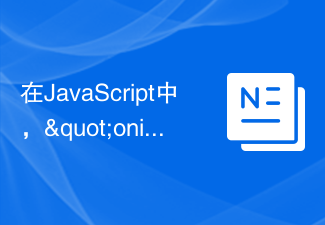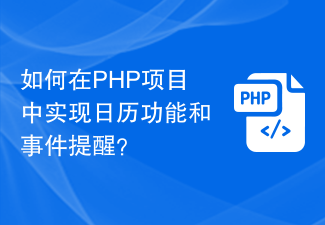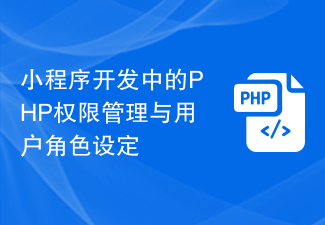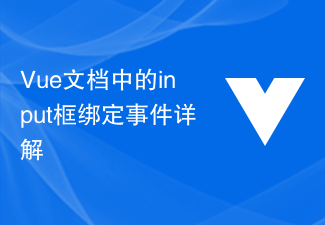As mentioned earlier, the WeChat applet framework is a design method for analyzing the logic layer and UI layer. This design method needs to solve two problems
The UI layer responds to changes in the logic and data of the logic layer
The UI layer feeds back the user's operations to the logic layer
The data binding mentioned earlier solves the first problem, and eventTo solve the second problem
What is an event
Events are the communication method from the view layer to the logic layer.
Events can feed back user behavior to the logic layer for processing.
Events can be bound to components. When the trigger event is reached, the corresponding event processing function in the logic layer will be executed.
Event objects can carry additional information, such as id, dataset, touches.
To summarize, an event refers to something happening, usually when the user performs some operation, such as clicking a button or sliding a finger on the phone screen. When an event occurs, the framework calls the event handling function (if any) so that it can respond to user operations.
Event Binding
Complete the response to user operations through event binding. For example, to handle the tap event of the view tag, in the tag Add bindtap = 'tapName' to the attribute, and then add tapName function in .js
//wxml
<view id="tapTest" data-hi="WeChat" bindtap="tapName"> Click me! </view>
//.js
Page({
tapName: function(event) {
console.log(event)
}
})The event object contains some data about the event:
target: the component that triggered the event
currentTarget: the current component
type: event type
timeStamp: timestamp ( The number of milliseconds that elapsed between the page opening and the event being triggered)
touches: an array containing touch points (multi-touch)
changedTouches: the changed touch points Array (multi-touch)
detail: additional custom information
Bubble events and non-bubble events
Why is there# The difference between ##target and currentTarget is because events are divided into two categories, bubble events and non-bubble events
Bubbling events: When an event on a component is triggered, the event will be passed to the parent node.TheNon-bubbling events: When an event on a component is triggered, the event will not be delivered to the parent node.
tap event is a bubbling event (this is why event in the above example contains currentTarget), and in addition Other bubbling events include | Type| Trigger Condition|
| ------------- |-------------|
| touchstart | The finger touch action starts|
| touchmove| The finger moves after touching|
| touchcancel| The finger touch action is interrupted, such as incoming call reminder, pop-up window|
| touchend| The finger touch action ends |
| tap | Leave immediately after touching the finger |
| longtap | Leave after more than 350ms after touching the finger |
catch event binding, such as catchtap, you can prevent the bubbling behavior of events.
You can use the following code example to deepen your understanding of bubbling events//.wxml
<view id="outter" bindtap="handleTapOutter">
我是父亲节点
<view id="middle" catchtap="handleTapMiddle">
我是儿子节点
<view id="inner" bindtap="handleInner">
我是孙子节点
</view>
</view>
</view>
//.js
Page({
handleTapOutter: function(event) {
console.log("父亲节点被点击")
},
handleTapMiddle: function(event) {
console.log("儿子节点被点击")
},
handleInner: function(event) {
console.log("孙子节点被点击")
},
})Try to modify the tap event binding method of nodes at all levels and see what changes will occur in the output logs. The above is the detailed content of Events in the Basics of Mini Program Development (9). For more information, please follow other related articles on the PHP Chinese website!
![事件 ID 4660:已删除对象 [修复]](https://img.php.cn/upload/article/000/887/227/168834320512143.png) 事件 ID 4660:已删除对象 [修复]Jul 03, 2023 am 08:13 AM
事件 ID 4660:已删除对象 [修复]Jul 03, 2023 am 08:13 AM我们的一些读者遇到了事件ID4660。他们通常不确定该怎么做,所以我们在本指南中解释。删除对象时通常会记录事件ID4660,因此我们还将探索一些实用的方法在您的计算机上修复它。什么是事件ID4660?事件ID4660与活动目录中的对象相关,将由以下任一因素触发:对象删除–每当从ActiveDirectory中删除对象时,都会记录事件ID为4660的安全事件。手动更改–当用户或管理员手动更改对象的权限时,可能会生成事件ID4660。更改权限设置、修改访问级别或添加或删除人员或组时,可能会发生这种情
 在iPhone锁屏上获取即将到来的日历事件Dec 01, 2023 pm 02:21 PM
在iPhone锁屏上获取即将到来的日历事件Dec 01, 2023 pm 02:21 PM在运行iOS16或更高版本的iPhone上,您可以直接在锁定屏幕上显示即将到来的日历事件。继续阅读以了解它是如何完成的。由于表盘复杂功能,许多AppleWatch用户习惯于能够看一眼手腕来查看下一个即将到来的日历事件。随着iOS16和锁定屏幕小部件的出现,您可以直接在iPhone上查看相同的日历事件信息,甚至无需解锁设备。日历锁定屏幕小组件有两种风格,允许您跟踪下一个即将发生的事件的时间,或使用更大的小组件来显示事件名称及其时间。若要开始添加小组件,请使用面容ID或触控ID解锁iPhone,长按
 PHP在小程序开发中的页面跳转与路由管理Jul 04, 2023 pm 01:15 PM
PHP在小程序开发中的页面跳转与路由管理Jul 04, 2023 pm 01:15 PMPHP在小程序开发中的页面跳转与路由管理随着小程序的快速发展,越来越多的开发者开始将PHP与小程序开发相结合。在小程序开发中,页面跳转和路由管理是非常重要的一部分,它能够帮助开发者实现页面之间的切换和导航操作。PHP作为一种常用的服务器端编程语言,可以很好地与小程序进行交互和数据传递,下面我们来详细了解一下PHP在小程序中的页面跳转与路由管理。一、页面跳转基
 在JavaScript中,"oninput"事件的用途是什么?Aug 26, 2023 pm 03:17 PM
在JavaScript中,"oninput"事件的用途是什么?Aug 26, 2023 pm 03:17 PM当在输入框中添加值时,就会发生oninput事件。您可以尝试运行以下代码来了解如何在JavaScript中实现oninput事件-示例<!DOCTYPEhtml><html> <body> <p>Writebelow:</p> <inputtype="text"
 如何在uniapp中实现小程序开发和发布Oct 20, 2023 am 11:33 AM
如何在uniapp中实现小程序开发和发布Oct 20, 2023 am 11:33 AM如何在uni-app中实现小程序开发和发布随着移动互联网的发展,小程序成为了移动应用开发的一个重要方向。而uni-app作为一个跨平台的开发框架,可以同时支持多个小程序平台的开发,如微信、支付宝、百度等。下面将详细介绍如何使用uni-app开发和发布小程序,并提供一些具体的代码示例。一、小程序开发前准备在开始使用uni-app开发小程序之前,需要做一些准备工
 如何在PHP项目中实现日历功能和事件提醒?Nov 02, 2023 pm 12:48 PM
如何在PHP项目中实现日历功能和事件提醒?Nov 02, 2023 pm 12:48 PM如何在PHP项目中实现日历功能和事件提醒?在开发Web应用程序时,日历功能和事件提醒是常见的需求之一。无论是个人日程管理、团队协作,还是在线活动安排,日历功能都可以提供便捷的时间管理和事务安排。在PHP项目中实现日历功能和事件提醒可以通过以下步骤来完成。数据库设计首先,需要设计数据库表来存储日历事件的相关信息。一个简单的设计可以包含以下字段:id:事件的唯一
 小程序开发中的PHP权限管理与用户角色设定Jul 04, 2023 pm 04:48 PM
小程序开发中的PHP权限管理与用户角色设定Jul 04, 2023 pm 04:48 PM小程序开发中的PHP权限管理与用户角色设定随着小程序的普及和应用范围的扩大,用户对于小程序的功能和安全性提出了更高的要求,其中权限管理和用户角色设定是保证小程序安全性的重要一环。在小程序中使用PHP进行权限管理和用户角色设定能够有效地保护用户的数据和隐私,下面将介绍如何实现这一功能。一、权限管理的实现权限管理是指根据用户的身份和角色,授予不同的操作权限。在小
 Vue文档中的input框绑定事件详解Jun 21, 2023 am 08:12 AM
Vue文档中的input框绑定事件详解Jun 21, 2023 am 08:12 AMVue.js是一种轻量级的JavaScript框架,具有易用、高效和灵活的特点,是目前广受欢迎的前端框架之一。在Vue.js中,input框绑定事件是一个十分常见的需求,本文将详细介绍Vue文档中的input框绑定事件。一、基础概念在Vue.js中,input框绑定事件指的是将输入框的值绑定到Vue实例的数据对象中,从而实现输入和响应的双向绑定。在Vue.j


Hot AI Tools

Undresser.AI Undress
AI-powered app for creating realistic nude photos

AI Clothes Remover
Online AI tool for removing clothes from photos.

Undress AI Tool
Undress images for free

Clothoff.io
AI clothes remover

AI Hentai Generator
Generate AI Hentai for free.

Hot Article

Hot Tools

MantisBT
Mantis is an easy-to-deploy web-based defect tracking tool designed to aid in product defect tracking. It requires PHP, MySQL and a web server. Check out our demo and hosting services.

mPDF
mPDF is a PHP library that can generate PDF files from UTF-8 encoded HTML. The original author, Ian Back, wrote mPDF to output PDF files "on the fly" from his website and handle different languages. It is slower than original scripts like HTML2FPDF and produces larger files when using Unicode fonts, but supports CSS styles etc. and has a lot of enhancements. Supports almost all languages, including RTL (Arabic and Hebrew) and CJK (Chinese, Japanese and Korean). Supports nested block-level elements (such as P, DIV),

Zend Studio 13.0.1
Powerful PHP integrated development environment

Dreamweaver CS6
Visual web development tools

Safe Exam Browser
Safe Exam Browser is a secure browser environment for taking online exams securely. This software turns any computer into a secure workstation. It controls access to any utility and prevents students from using unauthorized resources.







